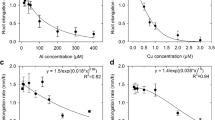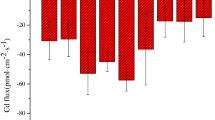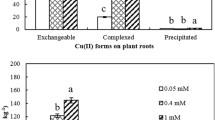Abstract
To study the mechanism of chelant-metal complexes to be absorbed into plant roots in the presence of different concentration chelating agents, the sites, pathways, and mechanism of absorption of Cu-EDDS complex ([S, S’]-ethylene diamine disuccinic acid) in maize (Zea mays L.) primary roots were systematically studied. The results showed that, at low concentrations of the Cu-EDDS complex (<200 μmol L−1) in hydroponic culture, the complex was passively absorbed mainly from the apoplastic spaces where lateral roots penetrate the endodermis and the cortical region into the root xylem, the lateral root zone were the main absorption sites. At higher concentrations (<3,000 μmol L−1), under hydroponic culture and soil culture conditions, the passage cells, which form a physiological barrier controlling ion absorption, were either injured or killed, and the complex could enter the root xylem. Injury to the physiological barrier was a key factor in the complex being absorbed by roots in substantially larger quantities. In addition, the histochemical analysis of rubeanic acid can also be used for other researches involving Cu, and the negative–pressure measuring device provides a new research tool for studying the apoplastic absorption of other metal–chelating complexes, molecules, and ions.





Similar content being viewed by others
References
Adrian AA (2002) Determination of strong binding chelators and their metal complexes by anion-exchange chromatography and inductively coupled plasma mass spectrometry. J Chromatogr A 947:205–216
Bakkaus E, Collins RN, Morel JL, Gouget B (2006) Anion exchange liquid chromatography–inductively coupled plasma-mass spectrometry detection of the Co2+, Cu2+, Fe3+ and Ni2+ complexes of mugineic and deoxymugineic acid. J Chromatogr A 1129:208–215
Bell PF, McLaughlin MJ, Cozens G, Stevens DP, Owens G, South H (2003) Plant uptake of 14C-EDTA, 14C-Citrate, and 14C-Histidine from chelator-buffered and conventional hydroponic solutions. Plant Soil 253:311–319
Collins RN, Onisko BC, McLaughlin MJ, Merrington G (2001) Determination of metal–EDTA complexes in soil solution and plant xylem by ion chromatography electrospray mass spectrometry. Environ Sci Technol 35:2589–2593
Collins RN, Merrington G, McLaughlin MJ, Knudsen C (2002) Uptake of intact zinc-ethylenediamine tetraacetic acid from soil is dependent on plant species and complex concentration. Environ Toxicol Chem 21:1940–1945
Epstein AL, Gussman CD, Blaylock MJ, Yermiyahu U, Huang JW, Kapulnik Y, Orser CS (1999) EDTA and Pb-EDTA accumulation in Brassica juncea grown in Pb–amended soil. Plant Soil 208:87–94
Evangelou MWH, Ebel M, Schaeffer A (2007) Chelate assisted phytoextraction of heavy metals from soil. Effect, mechanism, toxicity, and fate of chelating agents. Chemosphere 68:989–1003
Green CL (1955) Histochemical demonstration of copper in a case of hepatolenticular degeneration. Am J Pathol 31:545–553
Hernández-Allica J, Garbisu C, Barrutia O, Becerril JM (2007) EDTA-induced heavy metal accumulation and phytotoxicity in cardoon plants. Environ Exp Bot 60:26–32
Kawasaki T, Moritsugu M (1987) Effect of calcium on the absorption and translocation of heavy metals in excised barley roots: multi-compartment transport box experiment. Plant Soil 100:21–34
Knepper TP, Werner A, Bogenschűtz G (2005) Determination of synthetic chelating agents in surface and waste water by ion chromatography–mass spectrometry. J Chromatogr A 1085:240–246
Liu JF, Cheng YQ, Yan XF, Zhou G, Wang SF (2006) Improvement of plant cryo-sectioning technique. J Nanjing Forest Univ 30:128–130
Luo CL, Shen ZG, Li XD (2005) Enhanced phytoextraction of Cu, Pb, Zn and Cd with EDTA and EDDS. Chemosphere 59:1–11
Luo CL, Shen ZG, Li XD, Baker AJM (2006) Enhanced phytoextraction of Pb and other metals from artificially contaminated soils through the combined application of EDTA and EDDS. Chemosphere 63:1773–1784
Niu LY, Shen ZG (2009) Analysis of metal-complexes of ethylenediamine disuccinic acid in plant and soil by ion chromatography and mass spectrometry. Chin J Chromatogr 27:829–834
Okinaka S, Yoshikawa M, Toyoda M, Mozai T, Toyokura Y, Kameyama M (1954) Pathogenesis of hepatocerebral disease. II. Histochemical study of copper of liver and brain in Wilson’s disease. Arch Neurol Psychiatr (Chicago) 72:573–578
Orama M, Hyvonen H, Saarinen H, Aksela R (2002) Complexation of [S, S] and mixed stereoisomers of N, N-ethylenediaminedisuccinic acid (EDDS) with Fe(III), Cu(II), Zn(II) and Mn (II) ions in aqueous solution. J Chem Soc Dalton Trans 24:4644–4648
Pen CE, Li SG (2001) Histochemistry, Beijing, People’s Health Publishing Press, pp 200–205
Peterson CA, Emanuel ME, Humphreys GB (1981) Pathway of movement of apoplastic fluorescent dye tracers through the endodermis at the site of secondary root formation in corn (Zea mays) and broad bean (Vicia faba). Can J Bot 59:618–625
Ranathunge K, Steudle E, Lafitte R (2005) A new precipitation technique provides evidence for the permeability of Casparian bands to ions in young roots of corn (Zea mays L.) and rice (Oryza sativa L.). Plant. Cell Environ 28:1450–1462
Salt DE, Blaylock MJ, Kumar NPBA, Dushenkov V, Ensley BD, Chet I, Raskin I (1995) Phytoremediation: a novel strategy for the removal of toxic metals from the environment. Biotechnology 13:468–474
Sarret G, Vangronsveld J, Manceau A, Musso M, D’Haen J, Menthonnex JJ, Hazemann JL (2001) Accumulation forms of Zn and Pb in Phaseolus vulgaris in the presence and absence of EDTA. Environ Sci Technol 35:2854–2859
Schaider LA, Parker DR, Sedlak RL (2006) Uptake of EDTA-complexed Pb, Cd and Fe by solution and sand-cultured Brassica juncea. Plant Soil 286:377–391
Steudle E, Peterson CA (1998) How does water get through roots? J Exp Bot 322:775–788
Tandy S, Schulin R, Nowack B (2006) The influence of EDDS on the uptake of heavy metals in hydroponically grown sunflowers. Chemosphere 62:1454–1463
Tanton TW, Crowdy SH (1971) The distribution of lead chelate in the transpiration stream of higher plants. Pestic Sci 2:211–213
Tanton TW, Crowdy SH (1972) Water pathways in higher plants: II. Water pathways in roots. J Exp Bot 23:600–618
Vassil AD, Kapulnik Y, Raskin I, Salt DE (1998) The role of EDTA in lead transport and accumulation by Indian mustard. Plant Physiol 117:447–453
Xu JH, Tao Z, Huang Y, Sun JL (2004) A berberin-aniline blue counterstaining method for dying Caspary Band in root endodermis. Plant Physiol Commun 40:479–482
Yang JF, Pan D, Zhao CL, Sun YL, Zhao JM (2006) Express microwave copper staining at wilson disease transhepatic pathological diagnosis. Med J Chin People’s Liberation Army 31:735
Acknowledgments
We thank Li-Yang for the help in metal-EDDS complex analysis and elemental analysis, and Professor Honglan Lu for revising the manuscript. We also thank reviewers for his/her comments and suggestions on our manuscript. These comments and suggestions were highly insightful and enabled us to greatly improve the quality of our manuscript.This work was supported by the Natural Science Foundation of China (No: 20677029).
Author information
Authors and Affiliations
Corresponding author
Additional information
Responsible Editor: Juan Barcelo.
Rights and permissions
About this article
Cite this article
Niu, L., Shen, Z. & Wang, C. Sites, pathways, and mechanism of absorption of Cu-EDDS complex in primary roots of maize (Zea Mays L.): anatomical, chemical and histochemical analysis. Plant Soil 343, 303–312 (2011). https://doi.org/10.1007/s11104-011-0719-9
Received:
Accepted:
Published:
Issue Date:
DOI: https://doi.org/10.1007/s11104-011-0719-9




